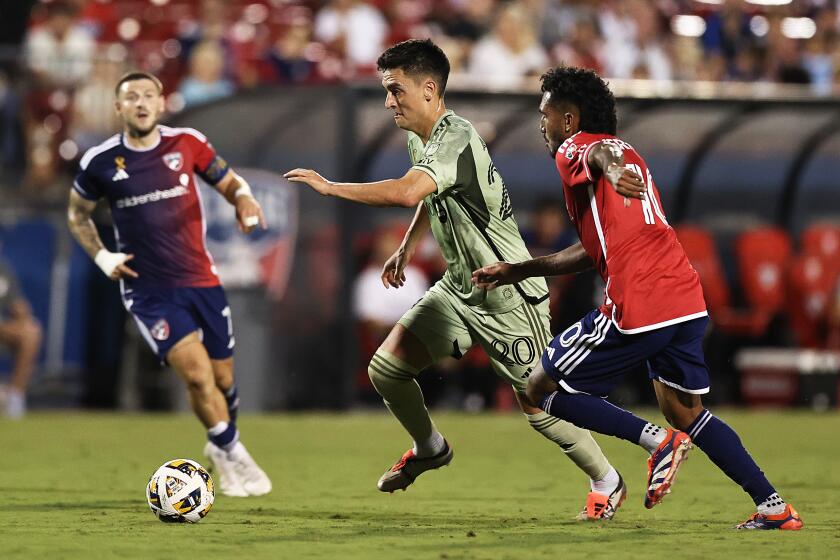How safe are fans?
Reporting from Sonoma, Calif.
A fan of off-road truck racing, Travis Wells accepted a friend’s invitation and drove from his Anaheim home to watch the trucks compete on a Saturday evening in an isolated patch of San Bernardino County’s Lucerne Valley.
“I had never been to a night race so I thought I’d enjoy that,” Wells, 23, recalled of his outing a week ago to the California 200. But the fun turned to horror when Wells suddenly found himself 50 feet from where one truck lost control and plowed into the crowd. Eight spectators died and 10 were injured.
“You don’t go there expecting that,” Wells said. “It’s highly unlikely. But it’s a possibility.”
The California 200 appeared unusual in that videos and witness accounts revealed that the spectators were exceptionally close to the speeding trucks without a barrier between them.
But even when fans are kept at a “safer” distance, danger lurks for spectators watching not only auto racing but professional baseball, golf, hockey and other sports. It’s latent risk, always present if rarely triggered, and one fans might not always think about. Then, in what’s typically labeled a “freak accident,” the risk turns real in an instant.
Sometimes it results in injuries that aren’t serious, other times they are, and sometimes the casualties are simply victims of being in the wrong place at the wrong time. Consider the past several months:
-- A 3-year-old girl suffered a fractured skull in June after being struck by a baseball hit into the stands by Dodgers catcher Russell Martin during batting practice at Dodger Stadium.
-- A woman died in February after being hit by a loose tire from a crashing dragster in a National Hot Rod Assn. event near Phoenix.
-- Tiger Woods struck spectators with his shots three separate times in one round in June at the Memorial Tournament in Dublin, Ohio.
-- Seven fans were injured by flying debris in April when the Ford driven by NASCAR driver Carl Edwards flipped on the track and soared into the grandstand fence at Talladega Superspeedway in Alabama.
But comprehensive, publicly available statistics on fan injuries aren’t easy to find, according to Dr. James Winslow of Wake Forest University’s Department of Emergency Medicine, who co-wrote a 2007 report, “Spectator Risks at Sporting Events,” that focused on baseball and hockey games.
“There’s very, very little out there” in terms of data, Dr. Winslow said in an interview. “If you knew what the actual risk was, you can make a better decision about assuming that risk, which is definitely out there.”
However measured, the risk is found in tiny print on the back of many sports’ tickets. On the back of a Dodgers ticket, for instance, it says the holder “assumes all risk and danger” that could be caused by “thrown bats and thrown or batted balls.”
“The single best thing we can do is to encourage [fans] to always keep your eye on the ball,” Dodgers spokesman Josh Rawitch said. “We can’t be in every seat and make sure people are paying attention to the game, but we certainly try to encourage them.”
Seats behind the home-plate area are protected with a backstop fence, but lower-level seats along the base lines are open to frequent foul balls and, on occasion, a flying bat. Yet sitting farther away doesn’t guarantee safety. A fan was hospitalized last month after tumbling 30 feet from the stands at Rangers Ballpark while trying to catch a foul ball.
Even when there are barriers for fans, safety isn’t assured. In 1997, the wife of hockey great Wayne Gretzky was knocked unconscious by the pane of protective glass around the rink at New York’s Madison Square Garden after the glass was jarred loose by two colliding players.
As the off-road tragedy illustrated, auto racing has produced some of the most harrowing experiences for spectators. Perhaps the worst disaster occurred in 1955 at Le Mans in France when a race car flew into the grandstands, killing the driver and more than 80 fans.
At the Indianapolis 500 in 1973, a major crash on the front straightaway spewed flame and flying parts through the fence in front of the stands, injuring 12 spectators and prompting Times columnist Jim Murray to write that “when the lions start to go up into the boxes after the Romans, it may be time to reexamine the ‘sport.’ ”
Other incidents have prompted motor sports to make changes. After the car of NASCAR’s Bobby Allison sailed into the fence at Talladega in 1987, sending debris into the stands and injuring four spectators, NASCAR mandated carburetor-restrictor plates at that track and Daytona International Speedway to put a cap on speeds.
They’re still in use, but that still didn’t prevent Edwards’ crash this year at Talladega.
Even so, while race car drivers “understand that they’re doing something that’s risky, fans who come to a motor race should not have to have an elevated expectation of risk,” said Steve Page, president of Infineon Raceway in Sonoma, which is hosting an Izod IndyCar Series race Sunday.
“Everything that we do, in terms of where we put our seating, where we put catch fences and barriers, is based around the assumption that this should be a safe experience” for fans, he said.
But as the Lucerne Valley accident showed, getting as close as possible to the action is part of the lure of live sports, regardless of how knowledgeable someone is about the hazards.
“People want to be close to things,” said Dr. Winslow, “to be near the danger.”
james.peltz@latimes.com
More to Read
Go beyond the scoreboard
Get the latest on L.A.'s teams in the daily Sports Report newsletter.
You may occasionally receive promotional content from the Los Angeles Times.










